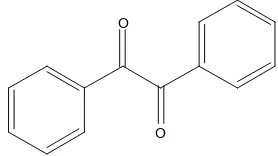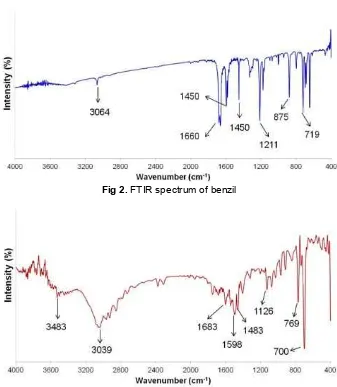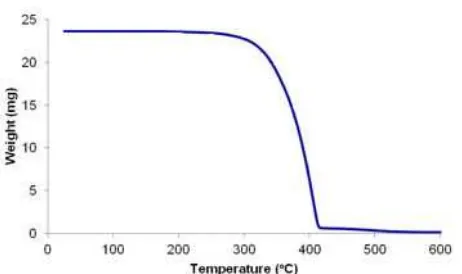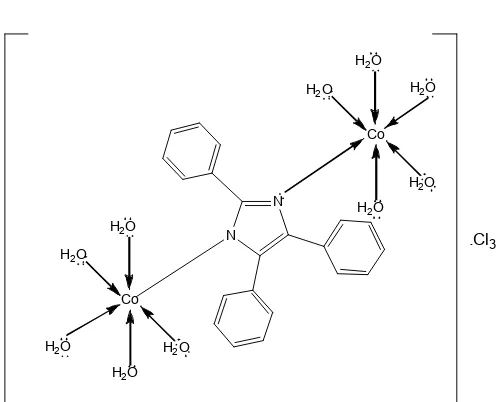Properties and Toxicity of Cobalt(II) Complex with 2,4,5-triphenyl-1H-imidazole Ligand
Fahimah Martak
*, Nuari Wahyu Dwi Cahyani,
Zjahra Vianita Nugraheni, and Wahyu Prasetyo Utomo
Department of Chemistry, Sepuluh Nopember Institute of Technology (ITS)Jl. Arief Rahman Hakim, Sukolilo, Surabaya 60111, Indonesia
Received December 2, 2015; Accepted May 24, 2016
ABSTRACT
Binuclear cobalt(II) complex with 2,4,5-triphenyl-1H-imidazole ligand has been synthesized using reflux method. The yellowish green crystals with needle-like shape were obtained. Determination of molecular formula of the complex was carried out using Atomic Absorption Spectroscopy (AAS) and CHN elemental analysis. The contents of carbon, hydrogen, nitrogen and cobalt(II) in the complex were 36.28, 5.32, 4.17, and 16.64% by weight, respectively. The calculation of element composition showed that the molecular formula of complex [(H2O)5
Co-L-Co(H2O)5]Cl3. The IR spectrum showed absorption peaks of Co-N and Co=O at 397.31 and 493.74 cm
-1
,
respectively, confirming the formation of complex. The complex compound showed paramagnetic properties with μeff
value of 3.18 BM. Toxicity of the complex was determined by Brine Shrimp Lethality Test (BSLT) method, and the LC50value of the complex was 362.24 mg/L.
Keywords:complex compound; cobalt(II); toxicity; paramagnetic; 2,4,5-triphenyl-1H-imidazole ligand
ABSTRAK
Senyawa kompleks binuklir kobalt(II) dengan ligan 2,4,5-trifenil-1H-imidazol telah berhasil disintesis menggunakan metode refluks. Kristal berwarna hijau kekuningan dan berbentuk jarum kecil berhasil diperoleh. Penentuan rumus molekul kompleks dilakukan dengan Spektroskopi Serapan Atom dan Analisis Mikrounsur CHN. Kandungan karbon (C), hidrogen (H), nitrogen (N) dan kobalt(II) (Co) dalam kompleks masing-masing sebesar 36,28, 5,32, 4,17, dan 16,64% berat. Perhitungan terhadap kandungan masing-masing unsur tersebut menunjukkan bahwa kompleks yang terbentuk memiliki rumus molekul [(H2O)5Co-L-Co(H2O)5]Cl3. Spektrum FTIR menunjukkan
puncak khas vibrasi Co-N dan Co-O masing-masing pada bilangan gelombang 397,31 dan 493,74 cm-1. Kompleks
bersifat paramagnetik dengan nilai μeffsebesar 3,18 BM. Uji toksisitas senyawa ini dilakukan dengan metode Brine
Shrimp Lethality Test (BSLT) dan dihasilkan nilai toksisitas LC50sebesar 362,24 mg/L.
Kata Kunci:senyawa kompleks; kobalt(II); toksisitas; paramagnetik; ligan 2,4,5-trifenil-1H-imidazol
INTRODUCTION
Imidazole compounds are widely studied and used in the pharmaceutical industry. Imidazoles are kind of five rings heterocyclic compounds that have special biological property [1]. Imidazoles are widely used as an antifungal, antiprotozoal and antihypertensive drug. Substituted imidazole, such as 1,5-diarylimidazol has interesting biological activity [2]. This compound possesses cytotoxicity property toward cancer cells of MCF-7, SF-268, and NCI-H460. The number and type of substituents on the imidazole ring influence the level of toxicity [3]. The complex [Co(DIPO)Br2] was used to inhibit the activity of Escherichia coliby 3 mL of volume
at 120 μg/20 μL of concentration. In contrast,
[Co(DIPO)Cl2] was used to inhibit by amount of 2.5 mL [4].
Sandoval et al. [5] had reported the biological activity of metal complexes of cobalt(II) with imidazole ligands derivatives. [M(albendazole)Cl2(H2O)].3H2O compounds with M = Co(II) and Zn(II) were reported to have anticancer activity. However, Co(II) complex showed higher anticancer activity of HeLa than that of Zn(II) complex. LC50 value of Co(II) complex was 36 mg/mL while Zn(II) complex was 100 mg/mL. The biological activity of complexes with other imidazole ligands derivatives such as 2-aminobenzimidazole had been reported by Kusmanovic et al. with M = Co (II), Ni (II) [6]. Complexes of Co(II) and Ni(II) inhibited microbial activity of Saccharomyces cerevisiae and
with imidazole ligand derivatives had better biological activity compared with other metal ions.
2,4,5-triphenyl-1H-imidazoles compound had structure that allows it to be a bridging ligand to form polymer complexes that have better stability [7]. Substitution on 2-, 4-, and 5- positions of imidazole ring had an effect on potential value of two nitrogen atoms binding to the imidazole ring. The steric effect in substituted imidazole could influence in the formation of metal complexes using imidazole ligands. Crystalline complex of 2,4,5-triphenyl-1H-imidazoles produced green light crystals. It formed six-coordinated complexes, so it could lead to the formation of two octahedral structures with 2,4,5-triphenyl-1H-imidazoles ligand as bridging ligand. The molecular formula of the complex was [(H2O)5Ni-Lop-Ni(OH2)5] (ClO4)3[8-9].
Based on the explanation above, it is possible to conduct further research of metal complexes of cobalt(II) with 2,4,5-triphenyl-1H-imidazoles ligand and measure the toxicity of these compounds. Toxicity test is easy to be performed using Artemia salina shrimp larvae. This method is very beneficial because it is very simple and cheap [10].
EXPERIMENTAL SECTION
Materials
Reagents used in this research were benzoin, NaOH, ethanol 95%, benzaldehyde, aquadest, aquademin, copper(II) acetate monohydrate (Cu(OAc)2.H2O), acetic acid glacial, ammonium acetate (NH4OAc), n-hexane, CoCl2.6H2O, chloroform, dichlorometane, concentrated HNO3, ethyl-acetate, KCl, MgCl2∙6H2O, and FeCl3.6H2O. All reactants were in analytical grade and purchased from Merck.
Instrumentation
Instruments used in this research were FTIR Shimadzu 84005, Photo Microscope Olympus cx21, Elemental Analyzer Thermo Finnigan EA 1112, Atomic Absorption Spectroscopy ZEEnit 700, Thermogravimetric Analysis Setaram Setsys-1750, Electric Conductivity Analysis Mettler Toledo and Magnetic Susceptibility Balance Sherwood Scientific LTD.
Procedure
Synthesis of 2,4,5-triphenyl-1H-imidazole ligand 2,4,5-triphenyl-1H-imidazole ligand was synthesized using reflux method. The method had been used in previous research [11]. Benzoin crystals were taken about 25 mmol and put into a flask. Benzaldehyde
(25 mmol), Cu-acetic (10 mmol) and ammonium acetic acid (130 mmol) were then dissolved in 100 mL ethanoic acid and added to the first flask contained benzoin crystals. The solution was heated in oil bath for an hour under stirring. The mixture was then cooled to room temperature and was filtered to remove precipitate, which might be formed. 500 mL of water was added to the filtrate. The filtrate was neutralized by adding ammonium hydroxide. The formed solids were filtered and collected. The solids were recrystallized by dissolving in aqueous ethanol. The distilled water was added to the ethanol until forming yellow precipitate (benzil, yellow crystals). The precipitate (benzil) was characterized using FTIR.
Benzil 0.42 g was taken and put into a beaker glass. Then, 4 drops of benzaldehyde and 1.5 g of ammonium acetate (NH4OAc) were dissolved in 30 mL of acetic acid glacial in flask. The mixture was refluxed at 118-120 °C for 3 h. The mixture was poured in beaker glass and 400 mL of demineralized water was added. The mixture was aged for 24 h to form precipitate. The precipitate was filtered and recrystallized in ethanol with addition of 250 mL demineralized water. Recrystallization process was repeated to obtain shiny white precipitate. The purity of the crystals was examined using TLC method using four combination of eluent namely chloroform :
n-hexane = 6:4, n-hexane : methylene chloride = 6:4,
n-hexane : ethyl acetate = 7:2 and methylene chloride : ethyl acetate = 8:2, respectively. After having purity test and melting point testing, the sample was characterized using FTIR,1H-NMR and13C-NMR.
Synthesis of complex Co(II) with 2,4,5-triphenyl-1H-imidazole ligand
Complex compound of Co(II) with 2,4,5-triphenyl-1H-imidazole ligand was synthesized using reflux method. 0.48 g of CoCl2.6H2O was taken and mixed with 0.30 g of ligand in 100 mL reflux flask. The ratio between ligand and metal was 1:2. 25 mL of ethanol was added and refluxed for 4 h under continuous stirring at 60–80 °C. The solution was aged at room temperature to form crystals. The crystals were filtered, washed with 5 mL of ethanol, and then dried in desiccator.
Elemental analysis of complex
O O
Atomic Absorption Spectroscopy
Atomic Absorption Spectroscopy (AAS) analysis was performed using CoCl2.6H2O as standard solution. Stock solution of Co(II) was prepared in concentration of 100 ppm. This stock solution was prepared by dissolving 0.0415 g CoCl2.6H2O with demineralized water in 100 mL volumetric flask with addition of 2 mL of concentrated HCl. After preparing stock solution, cobalt standard solutions were then prepared in concentration of 1, 2, 3, and 4 ppm by taking 0.5; 1; 1.5 and 2 mL of 100 ppm stock solutions and put into 50 mL volumetric flask. The solutions were diluted with demineralized water, which had been added with 1 mL of concentrated HCl.
The stock complex solution was also prepared in concentration of 100 ppm. This solution was prepared by weighing 0.0062 g of complex sample and put into 10 mL volumetric flask. The sample was added with 3 mL of concentrated HNO3 and dissolved in demineralized. The mother complex solution was then taken as much as 0.2 mL and diluted in 10 mL volumetric flask using demineralized water.
Thermogravimetric analysis
Thermogravimetric analysis (TGA) was performed by weighing 10-30 mg of sample. The samples were then placed in aluminum crucible during heating process. Analysis was performed with heating rates 10 °C/h at 20-500 °C. The measured initial sample weight was 23.7 mg.
FTIR analysis
Infrared spectroscopy analysis was performed using infrared spectrophotometer Shimadzu IR Prestige brand-21 in Instrument Laboratory, Department of Chemistry-ITS. The sample was ground and mixed with KBr powders with ratio about 1:100 of sample : KBr. The mixed powder was then pressed into pellets. The pellet was placed in sample holder and measured at wavenumber 400–4000 cm-1.
Electric conductivity analysis
Electric conductivity analysis was performed using standard solution of KCl, MgCl2∙6H2O, and FeCl3.6H2O with concentration of 0.01 M. The standard solutions were prepared using acetone as solvent. Sample (complex) solution was prepared in concentration of 0.01 M using the same solvent as standard solutions. This sample solution was prepared by dissolving 0.073 g of sample in 10 mL of acetone. The electrical conductivity of standard solutions and sample were measured with conductometer.
Magnetic moment measurement
Magnetic property of the complex was measured using Magnetic Susceptibility Balance (MSB). The
Fig 1.Proposed structure of benzil
obtained magnetic susceptibility values could be attributed to the magnetic moment of the sample at room temperature. The empty tube of MSB was then weighed its weight and measured its magnetic susceptibility. The obtained weight was signed as m0 and measured magnetic susceptibility as R0. The empty tube was then filled with sample up to 1.5 cm of tube height. The tube-containing sample was weighed (m) and placed in the MSB to measure the value of magnetic susceptibility (R).
Toxicity test
Toxicity tests were performed to determine the value of LC50 of the synthesized complexes (Lethal Concentration 50%, the concentration that causes 50% mortality in tested animal). The sample solutions for BSLT test were prepared in concentration of 25, 50, 100, 250, 500 and 1000 ppm. These sample solutions
were then taken as much as 15 μL and put in six different tubes (the tube capacity is of 30 μL). The
seawater containing 10-11 shrimp pups was added in each tube. The tubes were allowed to stand for 96 h. The died shrimp pups were counted. This test was performed three times.
RESULT AND DISCUSSION
Synthesis of 2,4,5-Triphenyl-1H-Imidazole Ligand
2,4,5-triphenyl-1H-imidazole ligand was synthesized by two stages method. The first step was the synthesis of benzil by oxidation of benzoin with the addition of Cu(II) acetate monohydrate as oxidator. In oxidation process, Cu2+ was reduced to be two Cu+ while benzoin was oxidized to be benzil. Reaction was carried out using reflux instrument for 2.5 hours at temperature of 100–115 °C. After completing the reaction, the mixture was filtered to separate the residual oxidant product with Cu(II) acetate monohydrate. The filtrate was then added with distilled water in order to form yellowish crystal of benzil.
Fig 2.FTIR spectrum of benzil
Fig 3.FTIR spectrum of ligand 2,4,5-triphenyl-1H-imidazole
closed to pure benzil melting point. This result showed that the resulted benzil had high purity. In addition, FTIR analysis was performed to determine the basic framework of the resulted benzil. FTIR spectrum analysis is shown in Fig. 2.
Based on the IR spectrum, a sharp peak with strong intensity at the 1660 cm-1indicates the presence of the C=O conjugated stretching. Sharp peak at 1211.21 cm-1 indicates the presence of a C–C bond bending of ketones. This result supports the prediction that the obtained data come from of benzil ketones compound. The peak at 3064.68 cm-1region proves the C–H bond stretching of the aromatic ring. The presence of the aromatic ring is also supported by the appearance of the peak at 1450.37 and 1593.09 cm-1which indicates the presence of C=C bond stretching aromatic ring. In addition, this is also supported by the presence of peaks in the area of 875.62 cm-1to 719.40 cm-1which is out of the plane vibration of the aromatic ring. These data are
in good agreement with the proposed benzil structure as shown in Fig. 1.
The second stage is synthesize of 2,4,5-triphenyl-1H-imidazole ligand. The reactants used in the synthesis of this ligand are benzil, ammonium acetate, and benzaldehyde. Synthesis was carried out at temperature of 118-120 °C by reflux method. Reactions were performed for 3 h. Then, the solution was transferred into a beaker glass and added with demineralized water. The solution was then aged for 24 h. The demineralized water was added to form the precipitate. The formed precipitate was filtered and recrystallized using ethanol. The precipitate was white in color. The yield of the synthesis of the ligand was about 50.87%. The purity of the ligand was determined using melting point test. The melting point was 275–278 °C. Results of FTIR analysis of the ligand is shown in Fig. 3.
HN N
Fig 4. Proposed structure of
2,4,5-triphenyl-1H-imidazole ligand Fig 5.Physical appereances of the complex
Table 1.Theoretical calculation of molecular formula based on AAS and CHN elemental analysis Elements Content (% by weight)
Molecular Formula
Co C H N
Sample (experiment) 16.64 36.28 5.32 4.17
[(H2O)3Cl2Co-L-Co(H2O)5]Cl 18.03 38.58 3.24 4.29 [(H2O)4ClCo-L-Co(H2O)4Cl]Cl 18.03 38.58 3.24 4.29 [(H2O)5Co-L-Co(H2O)4Cl]Cl2 17.29 36.99 4.89 4.11 [(H2O)5Co-L-Co(H2O)5]Cl3 26.84 36.05 5.05 4.01
The presence of the nitrogen atom in the ligand is also supported by the peak at 1126.35 cm-1region indicating the presence of C–N bonds in the ligand. The peak at 1683.83 cm-1 region is attributed to the C=N bond. The presence of aromatic rings is indicated by the peak at 3039.6 cm-1. The peaks at 1485.09 cm-1 region and 1598.88 cm-1 indicate the presence of aromatic C=C bonds. In addition, the presence of aromatic rings prediction is supported by the presence of out-of-plane aromatic peaks at 769.54 and 700.11 cm-1 region. The presence of these peaks in the FTIR spectrum support the proposed structure of ligand 2,4,5-triphenyl-1H-imidazole as shown in Fig. 4.
To determine the proton environment of 2,4,5-triphenyl-1H-imidazole ligand, the ligand was analyzed using1H-NMR and13C-NMR. The result of the 1H-NMR
shows some peaks at (400 MHz, DMSO-d6) δ 12.71 (s,
1H, NH), 8.09 (d, 2H, J 7.0 Hz), 7.22 to 7.57 (m, 13H ), while the peaks form of the 1H-NMR data appeared at
(75 MHz, DMSO-d6) δ 145.49; 137.5; 135.17; 131.09;
130.35; 128.69; 128.46; 128.25; 128.19; 127.79; 127.07; 126.52; 125.18. The results of NMR analysis support the structure that has been proposed in Fig. 4.
Synthesis of Complex Co(II) with Ligand 2,4,5-Triphenyl-1H-Imidazole
Cobalt(II) with the 2,4,5-triphenyl-1H-imidazole ligand was synthesized by applying metal and ligand ratio of 2:1. CoCl2.6H2O salt was used as a source of Co(II) metal ions. The solvent was ethanol. Ethanol was selected to be the solvent because ethanol was more volatile than water. In addition, the ligand 2,4,5-triphenyl-1H-imidazole was insoluble in water and could be
dissolved in ethanol. Synthesis was carried out using reflux method at 70-80 °C under stirring to accelerate the formation reaction of complex compound. The solution was then placed in a beaker glass, and aged for 6 days to grow the crystals. The formed crystals were washed with ethanol to remove impurities. The physical appearance of the complex Co(II) are shown in Fig. 5.
Elemental Analysis of Complex
The amount of Co(II) ion in the complex was determined using Atomic Absorption Spectroscopy (AAS). The result show that the content of Co(II) was 16.64%. By comparing the ion contents based on theoretical calculation and experimental, the molecular formula of complex could be predicted. The experimentally content of Co(II) was really closed to content in the molecular formula of [(H2O)5 Co-L-Co(H2O)5]Cl3 (16.84%) as shown in Table 1. Thus the early prediction was that the complex has molecular formula of [(H2O)5Co-L-Co(H2O)5]Cl3.
Fig 7. FTIR spectrum of complex of Co(II) with ligand 2,4,5-triphenyl-1H-imidazole
Table 2. Molar conductivity data of complex Co(II) with the ligand 2,4,5-triphenyl-1H-imidazole compounds and some comparison Complex compound in acetone 15.93 1 : 3
nitrogen in theoretical calculation were quite similar. However, the most suitable result based on the experimental results and theoretical results was complex with the molecular formula of [(H2O)5Co-L-Co (H2O)5]Cl3. The data from CHN analysis compiled with AAS analysis confirm that molecular formula.
Thermogravimetric Analysis (TGA)
Thermogravimetric analysis was carried out to estimate the species, which decomposed or left. It could be determined by comparing the weight of the sample at certain decomposition temperatures to the initial weight. The result of the analysis by Thermal Gravimetric Analyzer (TGA) of complex compounds is shown in Fig. 6.
The thermogram shows that there is no decomposition at 120-150 °C indicating that the complex does not contain any adsorbed water. Decomposition peak appears between 270-410 °C. In this temperature, the weight loss is about 93.63%. The weight loss is predicted to be the lost of 2,4,5-triphenyl-1H-imidazole ligand, water ligands, and two moles of chlorine. The remaining weight of 1.51 mg is estimated as 1 mole of chlorine hence it is in line with the prediction of complex compounds with the formula of [(H2O)5 Co-L-Co(H2O)5]Cl3.
FTIR Analysis
FTIR spectrum is shown in Fig. 7. The presence of wide peak at wavenumber of 3433.06 cm-1indicates the presence of O–H groups attached to the Co ion. The peak at 3039.60 cm-1region is the stretching peak of aromatic C–H bonds. The presence of aromatic ring is also supported by the presence of peaks at 1461.944 cm-1 and 1600.81 cm-1 which indicate the presence of aromatic C=C bonds. In addition, there are also out-of-plane peaks of the aromatic ring at 671.18 and 767.62 cm-1. The presence of Cl bond is predicted by the presence of peak on area of 605.61 cm-1. Co–N bond is shown at the wavenumber 400-230 cm-1 while the Co-O bond is observed at 493.74 cm-1 region [13].
Electric Conductivity Analysis
Electric conductivity is generally used to determine the ability of solution in delivering electric current. Electric conductivity is also associated with the movement of ions in solution. The easier ion to move, the higher electric conductivity of the solution. The electric conductivity of the complex was measured to determine the movement of ions in the compound.
Electric conductivity measurements was performed on standard solutions and sample solutions with concentration of 0.01 M. The standard solutions were KCl as standard solution for charge of +1, MgCl2 solution as a standard charge of +2 and FeCl3solution as standard charge of +3. The measurement was carried out at room temperature. The resulted data are shown in Table 2. The data in Table 2 show that the formed complex compound is electrolytes because it has unique electrical conductivity. By comparing the molar conductivity of complex solution with standard solution, it is obtained that the closest comparison is 1:3. This result shows that the complex is containing 3+ cations.
Magnetic Moment Measurement
N N
Co H2O
H2O
H2O H2O
H2O
Co H2O
H2O
H2O H2O
H2O
.Cl3
Fig 8. Structure prediction of [(H2O)5Co-L-Co(H2O)5]Cl3 complex
Fig 9.Graph of BSLT test
Table 3.Determination of LC50using BSLT method Concentration (ppm) Percent of Mortality (%)
25 0
50 3.23
100 12.67
250 33.33
500 65.30
1000 100
Structure Prediction of Complex
Based on the previous characterization, the molecular structure of complex compound was [(H2O)5Co-L-Co(H2O)5]Cl3 with L=2,4,5-triphenyl-1H-imidazole. This complex is predicted to have a molecular structure as shown in Fig. 8.
The result of FTIR spectrum indicates Co-N and Co-O bonding at wavenumber 397.31 and 493.74 cm-1, respectively. The complex is predicted to have ten H2O molecules and a 2,4,5-triphenyl-1H-imidazole ligand. In addition, the complex is also predicted as binuclear
complex according to the synthesis process that use the ratio of metal : ligand of 2:1. Structure prediction is also supported by the results of the analysis of electric conductivity. It shows that the formed complex is cation complex.
Toxicity Test
In toxicity test, the sample concentrations were varied at 25, 50, 100, 250, 500, and 1000 ppm. Each concentration measurements were repeated three times (triplo analysis). The data of number of mortality in each concentration variations are shown in Table 3. The plot of log concentration against percent (%) of mortality is shown in Fig. 9.
Based on the data on Table 3, the higher concentration of the test solution, the higher mortality in the test animals. About 50% of shrimp pups mortality occurred at concentrations between 250-500 ppm. By calculation using the polinomial regression equation, the LC50 value is 362.24 ppm. This is consistent with result reported by Nurhayati that states the higher the concentration of the solution, the higher of natural toxicity [15]. The obtained LC50 value is greater than the value of the pure compound toxicity limit of 200 ppm [14]. The LC50value of 362.24 mg/L indicates that the complex compound is not toxic.
CONCLUSION
Binuclear complex compound of Co(II) with the 2,4,5-triphenyl-imidazole-1H ligand had been successfully synthesized. The product were yellowish green needle-like crystal. The data from AAS and elemental analysis measurement showed the content of element contained in complex correspond to its molecular formula of [(H2O)5Co-L-Co(H2O)5]Cl3. Results of FTIR analysis showed the presence of Co–N and the Co–O bond at wavenumber of 397.31 and 493.74 cm-1, respectively. Hydroxyl groups of O-H, aromatic C-H, aromatic C=C, and Cl groups in each complex compounds were indicated by peaks at wavenumber of 3433.06, 3039.60, 1600.81 and 605.61 cm-1, respectively. The electric conductivity analysis showed that the complex was 3+ cation complex. The resulted complex compound was paramagnetic with magnetic moment value of 3.18 BM. This was consistent with the cobalt(II) metal ion which had three unpaired electrons. The LC50 value of complex was 362.24 mg/L, which was not toxic.
ACKNOWLEDGEMENT
and Culture of Indonesia for funding this research by scheme of Hibah Penelitian Kompetensi 2014 no 01754/IT2.11/PN.09/2014 and Laboratory of Natural Product Chemistry and Synthesis, Department of Chemistry ITS for technical supports.
REFERENCES
1. Paone, D.V., and Shaw, A.W., 2008, Tetrahedron Lett., 49 (42), 6155–6159.
2. Bhatnagar, A., Sharma, P.K., and Kumar, N., 2011,
Int. J. PharmTech Res., 3 (1), 268–282.
3. Pastor, I. M., and Yus, M., 2009,Curr. Chem. Biol., 3, 385–408.
4. Rehman, S., Ikram, M., Rehman, S., Faiz, A., and Shahnawaz, 2009, Bull. Chem. Soc. Ethiop., 24 (2), 201–207.
5. López-Sandoval, H., Londoño-Lemos, M.E., Garza-Velasco, R., Poblano-Meléndez, I., Granada-Macías, P., Gracia-Mora, I., and Barba-Behren, N., 2008,J. Inorg. Biochem., 102 (5-6), 1267–1276.
6. Kusmanovic, S., Ljiljana V., and Dragoljub, 2008, J. Appl. Pharm. Sci., 1267–1276.
7. Zala, S.P., Badmanaban, R., Sen, D.J., and Patel, C.N., 2012,J. Appl. Pharm. Sci., 2 (7), 202–208. 8. Qasim, S.S., Nasreen, S., and Ali, S.S., 2011,Int.
J. Appl. Biol. Pharm. Technol., 2 (2), 12–18. 9. Dutta, S., 2010,Acta Pharm., 60, 229–235.
10. Krishnaraju, A.V., Rao, T.V.N., Sundararaju, D., Vanisree, M., Tsay, H.S., and Subbaraju, G.V., 2005,Int. J. Appl. Sci. Eng., 3 (2), 125–134.
11. Bellina, F., Cauteruccio, S., and Rossi, R., 2007,
Tetrahedron, 63 (22), 4571–4624.
12. Marzouk, A., Vagif, M.A., Avtandil, H.T., and Shaaban, K.M., 2013, World J. Org. Chem., 1 (1), 6–10.
13. Betanzos-Lara, S., Gracia-Mora, I., Granada-Marcías, P., Flores-Álamo, M., and Barba-Behrens, N., 2013,Inorg. Chim. Acta, 397, 94–100.
14. Rafique, S., Idrees, M., Nasim, A., Akbar, H., and Athar, A., 2010, Biotechnol. Mol. Biol. Rev., 5 (2), 38–45.




